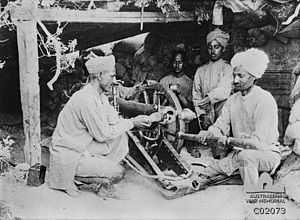BL 10-pounder mountain gun
| Ordnance BL 10-pounder mountain gun | |
|---|---|

Indian Army 10 pounder mountain gun and crew, Gallipoli, 1915
|
|
| Type | Mountain gun |
| Place of origin | United Kingdom of Great Britain and Ireland |
| Service history | |
| In service | 1901–1918 |
| Used by |
United Kingdom of Great Britain and Ireland British Raj |
| Wars | World War I |
| Production history | |
| Manufacturer | Woolwich Arsenal, Elswick Ordnance Company (UK) |
| Variants | MK I |
| Specifications | |
| Weight | Breech: 207 lb (93.9 kg) Barrel: 197 lb (89.36 kg) Total: 874 lb (396.4 kg) |
| Barrel length | Bore: 72.4 in (1.8 m) Total: 76.4 in (1.9 m) |
|
|
|
| Shell | Shrapnel, Common shell 10 pounds (4.54 kg) |
| Calibre | 2.75 inches (69.8 mm) |
| Action | Breech Loading with separate shell and charge |
| Recoil | None |
| Carriage | Wheeled, box trail |
| Elevation | -15° - 25° |
| Traverse | 0° |
| Muzzle velocity | 1,289 ft/s (393 m/s) |
| Effective firing range | 3,700 yards (3,383 m) (Time Fuze) 6,000 yards (5,486 m) (Percussion fuze) |
The Ordnance BL 10 pounder mountain gun was developed as a BL successor to the RML 2.5 inch screw gun which was outclassed in the Second Boer War.
This breech-loading gun was an improvement on the 2.5 inches (63.5 mm) muzzle-loading screw gun but still lacked any recoil absorber or recuperator mechanism. It could be dismantled into 4 loads of approximately 200 pounds (90.7 kg) for transport, typically by mule.
It was originally manufactured without a gun shield, but these were made and fitted locally during World War I e.g. at Nairobi in 1914 for the East Africa campaign, also at Suez in 1915 for the Gallipoli campaign.
It was eventually replaced by the BL 2.75 inch Mountain Gun from 1914 onwards but was still the main mountain gun in service when World War I began.
British mountain guns were operated by men of the Royal Garrison Artillery.
Guns of the 26th Mountain Battery of the Indian Army were the first British Empire artillery to open fire in the Middle East in World War I, on 26 January 1915, Qantara (Kantara), against the Turkish advance towards the Suez Canal.
The gun was used notably in the Battle of Gallipoli in 1915 by Indian Armies 21st (Kohat) Mountain Battery (Frontier Force) and 26th (Jacobs) Mountain Battery of the 7th Indian Mountain Brigade with 6 guns each at Anzac, and by Scottish Territorial Force (1/4th Highland Mountain Brigade) Argyllshire and Ross & Cromarty Batteries with 4 guns each at Helles and then Suvla. The 21st Battery was granted the title "Royal" in 1922 for its actions including Gallipoli, unique for an artillery battery.
...
Wikipedia
